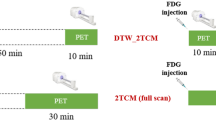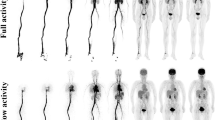Abstract
Purpose
Kinetic parameters from dynamic 18F-fluorodeoxyglucose (FDG) imaging offer complementary insights to the study of disease compared to static clinical imaging. However, dynamic imaging protocols are cumbersome due to the long acquisition time. Long axial field-of-view (LAFOV) PET scanners (> 70 cm) have two advantages for dynamic imaging over clinical PET scanners with a standard axial field-of-view (SAFOV; 16–30 cm). The large axial coverage enables multi-organ dynamic imaging in a single bed position, and the high sensitivity may enable clinically routine abbreviated dynamic imaging protocols.
Methods
In this work, we studied two abbreviated protocols using data from a 65-min dynamic 18F-FDG scan: (A) dynamic imaging immediately post-injection (p.i.) for variable durations, and (B) dynamic imaging immediately p.i. for variable durations plus a 1-h p.i. (5-min-long) datapoint. Nine cancer patients were imaged on the Biograph Vision Quadra (Siemens Healthineers). Time-activity curves over the lesions (N = 39) were fitted using the Patlak graphical analysis and a 2-tissue-compartment (2C, k4 = 0) model for variable scan durations (5–60 min). Kinetic parameters from the complete dataset served as the reference. Lesions from all cancers were grouped into low, medium, and high flux groups, and bias and precision of Ki (Patlak) and Ki, K1, k2, and k3 (2C) were calculated for each group.
Results
Using only early dynamic data with the 2C (or Patlak) model, accurate quantification of Ki required at least 50 (or 55) min of dynamic data for low flux lesions, at least 30 (or 40) min for medium flux lesions, and at least 15 (or 20) min for high flux lesions to achieve both 10% bias and precision. The addition of the final (5-min) datapoint allowed for accurate quantification of Ki with a bias and precision of 10% using only 10–15 min of early dynamic data for either model.
Conclusion
Dynamic imaging for 10–15 min immediately p.i. followed by a 5-min scan at 1-h p.i can accurately and precisely quantify 18F-FDG on a long axial FOV scanner, potentially allowing for more widespread use of dynamic 18F-FDG imaging.







Similar content being viewed by others
References
Wahl RL, Jacene H, Kasamon Y, Lodge MA. From RECIST to PERCIST: evolving considerations for PET response criteria in solid tumors. J Nucl Med. 2009;50:122S-S150.
Visser EP, Boerman OC, Oyen WJ. SUV: from silly useless value to smart uptake value. J Nucl Med. 2010;51:173–5.
Lodge MA. Repeatability of SUV in oncologic 18F-FDG PET. J Nucl Med. 2017;58:523–32.
Aide N, Lasnon C, Veit-Haibach P, Sera T, Sattler B, Boellaard R. EANM/EARL harmonization strategies in PET quantification: from daily practice to multicentre oncological studies. Eur J Nucl Med Mol Imaging. 2017;44:17–31. https://doi.org/10.1007/s00259-017-3740-2.
Beaulieu S, Kinahan P, Tseng J, Dunnwald LK, Schubert EK, Pham P, et al. SUV varies with time after injection in 18F-FDG PET of breast cancer: characterization and method to adjust for time differences. J Nucl Med. 2003;44:1044–50.
Tseng J, Dunnwald LK, Schubert EK, Link JM, Minoshima S, Muzi M, et al. 18F-FDG kinetics in locally advanced breast cancer: correlation with tumor blood flow and changes in response to neoadjuvant chemotherapy. J Nucl Med. 2004;45:1829–37.
Doot RK, Kurland BF, Kinahan PE, Mankoff DA. Design considerations for using PET as a response measure in single site and multicenter clinical trials. Acad Radiol. 2012;19:184–90.
Doot RK, McDonald ES, Mankoff DA. Role of PET quantitation in the monitoring of cancer response to treatment: review of approaches and human clinical trials. Clin Transl Imaging. 2014;2:295–303.
Dimitrakopoulou-Strauss A, Strauss LG, Heichel T, Wu H, Burger C, Bernd L, et al. The role of quantitative 18F-FDG PET studies for the differentiation of malignant and benign bone lesions. J Nucl Med. 2002;43:510–8.
Dimitrakopoulou-Strauss A, Strauss LG, Schwarzbach M, Burger C, Heichel T, Willeke F, et al. Dynamic PET 18F-FDG studies in patients with primary and recurrent soft-tissue sarcomas: impact on diagnosis and correlation with grading. J Nucl Med. 2001;42:713–20.
Alberts I, Prenosil G, Mingels C, Bohn KP, Viscione M, Sari H, et al. Feasibility of late acquisition [68Ga]Ga-PSMA-11 PET/CT using a long axial field-of-view PET/CT scanner for the diagnosis of recurrent prostate cancer-first clinical experiences. Eur J Nucl Med Mol Imaging. 2021;48:4456–62. https://doi.org/10.1007/s00259-021-05438-5.
Alberts I, Sachpekidis C, Prenosil G, Viscione M, Bohn KP, Mingels C, et al. Digital PET/CT allows for shorter acquisition protocols or reduced radiopharmaceutical dose in [18F]-FDG PET/CT. Ann Nucl Med. 2021;35:485–92. https://doi.org/10.1007/s12149-021-01588-6.
Karakatsanis NA, Casey ME, Lodge MA, Rahmim A, Zaidi H. Whole-body direct 4D parametric PET imaging employing nested generalized Patlak expectation–maximization reconstruction. Phys Med Biol. 2016;61:5456.
Karakatsanis NA, Garibotto V, Rager O, Zaidi H. Continuous bed motion vs. step-and-shoot acquisition on clinical whole-body dynamic and parametric PET imaging. In: Conference Record of the 2015 IEEE Nuclear Science Symposium and Medical Imaging Conference. Piscataway, NJ: IEEE; 2015. pp. 1–6.
Surti S, Pantel AR, Karp JS. Total body PET: why, how, what for? TRPMS. 2020;4:283–92.
Viswanath V, Pantel AR, Daube-Witherspoon ME, Doot R, Muzi M, Mankoff DA, et al. Quantifying bias and precision of kinetic parameter estimation on the PennPET Explorer, a long axial field-of-view scanner. IEEE Trans Radiat Plasma Med Sci. 2020;4:735–49. https://doi.org/10.1109/trpms.2020.3021315.
Spencer BA, Berg E, Schmall JP, Omidvari N, Leung EK, Abdelhafez YG, et al. Performance evaluation of the uEXPLORER total-body PET/CT scanner based on NEMA NU 2–2018 with additional tests to characterize PET scanners with a long axial field-of-view. J Nucl Med. 2021;62:861–70. https://doi.org/10.2967/jnumed.120.250597.
Viswanath V, Daube-Witherspoon ME, Pantel AR, Parma MJ, Werner ME, Karp JS. Performance benefits of extending the AFOV of PET scanners. n: Conference Record of the 2020 IEEE Nuclear Science Symposium and Medical Imaging Conference. Piscataway, NJ: IEEE; 2020. pp. 1–7.
Prenosil GA, Sari H, Fürstner M, Afshar-Oromieh A, Shi K, Rominger A, et al. Performance characteristics of the Biograph Vision Quadra PET/CT system with long axial field of view using the NEMA NU 2–2018 standard. J Nucl Med. 2021. https://doi.org/10.2967/jnumed.121.261972.
Zhang X, Xie Z, Berg E, Judenhofer MS, Liu W, Xu T, et al. Total-body dynamic reconstruction and parametric imaging on the uEXPLORER. J Nucl Med. 2020;61:285–91.
Wang G, Nardo L, Parikh M, Lara P, Spencer B, Qi J, et al. Simultaneous imaging of cancer and heart using total-body multiparametric PET on EXPLORER. J Nucl Med. 2021;62(suppl. 1):1447.
Wang Y, Cherry S, Badawi R, Wang G. Effect of dual-input function and dispersion on lung FDG-PET kinetic quantification using the EXPLORER total-body PET/CT scanner. J Nucl Med. 2020;61(suppl. 1):13.
Sari H, Hong J, Eriksson L, Shi K, Conti M, Alberts I, et al. Kinetic modelling of dynamic 18F-FDG datasets from long axial field-of-view PET scanner. J Nucl Med. 2021;62(suppl. 1):1405.
Strauss LG, Pan L, Cheng C, Haberkorn U, Dimitrakopoulou-Strauss A. Shortened acquisition protocols for the quantitative assessment of the 2-tissue-compartment model using dynamic PET/CT 18F-FDG studies. J Nucl Med. 2011;52:379–85. https://doi.org/10.2967/jnumed.110.079798.
Wu Y, Feng T, Zhao Y, Xu T, Fu F, Huang Z, et al. Whole-body parametric imaging of FDG PET using uEXPLORER with reduced scan time. J Nucl Med. 2021. https://doi.org/10.2967/jnumed.120.261651.
Sari H, Mingels C, Alberts I, Hu J, Buesser D, Shah V, et al. First results on kinetic modelling and parametric imaging of dynamic 18F-FDG datasets from a long-axial FOV PET scanner in oncological patients. Eur J Nucl Med Mol Imaging. 2022;(0123456789). https://doi.org/10.1007/s00259-021-05623-6.
Boellaard R, Delgado-Bolton R, Oyen WJ, Giammarile F, Tatsch K, Eschner W, et al. FDG PET/CT: EANM procedure guidelines for tumour imaging: version 2.0. Eur J Nucl Med Mol Imaging. 2015;42:328–54. https://doi.org/10.1007/s00259-014-2961-x.
Cheng G, Torigian DA, Zhuang H, Alavi A. When should we recommend use of dual time-point and delayed time-point imaging techniques in FDG PET? Eur J Nucl Med Mol imaging. 2013;40:779–87.
Dimitrakopoulou-Strauss A, Pan L, Sachpekidis C. Kinetic modeling and parametric imaging with dynamic PET for oncological applications: general considerations, current clinical applications, and future perspectives. Eur J Nucl Med Mol Imaging. 2021;48:21–39.
Patlak CS, Blasberg RG. Graphical evaluation of blood-to-brain transfer constants from multiple-time uptake data. Generalizations. J Cereb Blood Flow Metab. 1985;5:584–90.
PMOD Kinetic Modeling Toolkit (PKIN). https://www.pmod.com/files/download/v31/doc/pkin/2326.htm. Accessed 04 Feb 2022.
Minn H, Zasadny KR, Quint LE, Wahl RL. Lung cancer: reproducibility of quantitative measurements for evaluating 2-[F-18]-fluoro-2-deoxy-D-glucose uptake at PET. Radiol. 1995;196:167–73.
Dimitrakopoulou-Strauss A, Strauss LG, Burger C, Rühl A, Irngartinger G, Stremmel W, et al. Prognostic aspects of 18F-FDG PET kinetics in patients with metastatic colorectal carcinoma receiving FOLFOX chemotherapy. J Nucl Med. 2004;45:1480–7.
Dimitrakopoulou-Strauss A, Georgoulias V, Eisenhut M, Herth F, Koukouraki S, Mäcke HR, et al. Quantitative assessment of SSTR2 expression in patients with non-small cell lung cancer using 68Ga-DOTATOC PET and comparison with 18F-FDG PET. Eur J Nucl Med Mol Imaging. 2006;33:823–30.
Graham M, Peterson L, Hayward R. Comparison of simplified quantitative analyses of FDG uptake. Nucl Med Biol. 2000;27:647–55.
Alberts I, Hünermund J-N, Prenosil G, Mingels C, Bohn KP, Viscione M, et al. Clinical performance of long axial field of view PET/CT: a head-to-head intra-individual comparison of the Biograph Vision Quadra with the Biograph Vision PET/CT. Eur J Nucl Med Mol Imaging. 2021:1–10.
McCready VR, Dizdarevic S, Beyer T. Lesion detection and administered activity. J Nucl Med. 2020;61:1406–10.
Li Y, Matej S, Karp JS. Practical joint reconstruction of activity and attenuation with autonomous scaling for time-of-flight PET. Phys Med Biol. 2020;65:235037.
Teimoorisichani M, Panin V, Rothfuss H, Sari H, Rominger A, Conti M. A CT-less approach to quantitative PET imaging using the LSO intrinsic radiation for long-axial FOV PET scanners. Med Phys. 2021. https://doi.org/10.1002/mp.15376.
Rahmim A, Rousset O, Zaidi H. Strategies for motion tracking and correction in PET. PET Clin. 2007;2:251–66. https://doi.org/10.1016/j.cpet.2007.08.002.
Ren S, Lu Y, Bertolli O, Thielemans K, Carson RE. Event-by-event non-rigid data-driven PET respiratory motion correction methods: comparison of principal component analysis and centroid of distribution. Phys Med Biol. 2019;64:165014. https://doi.org/10.1088/1361-6560/ab0bc9.
Badawi RD, Shi H, Hu P, Chen S, Xu T, Price PM, et al. First human imaging studies with the EXPLORER total-body PET scanner. J Nucl Med. 2019;60:299–303.
Alberts I, Sachpekidis C, Dijkstra L, Prenosil G, Gourni E, Boxler S, et al. The role of additional late PSMA-ligand PET/CT in the differentiation between lymph node metastases and ganglia. Eur J Nucl Med Mol Imaging. 2020;47:642–51. https://doi.org/10.1007/s00259-019-04552-9.
Funding
This work was supported by the following grants: NIH R01 CA225874 and NIH R01 C113941, along with a research contract between the University of Pennsylvania and Siemens Medical Solutions and a research agreement between Insel Gruppe AG, Bern, Switzerland, and Siemens Healthcare AG, Zürich, Switzerland.
Author information
Authors and Affiliations
Corresponding author
Ethics declarations
Ethics approval
The local Institutional Review Board approved the study (KEK 2019–02193) and written informed consent was obtained from all patients. The study was performed in accordance with the declaration of Helsinki.
Competing interests
HS is a full-time employee of Siemens Healthineers AG. LE and MC are full time employees of Siemens Medical Solutions USA, Inc. AR has received research support and speaker honoraria from Siemens Healthineers. ILA declares no conflict of interest. The other authors have no relevant financial or non-financial interests to disclose.
Additional information
Publisher's note
Springer Nature remains neutral with regard to jurisdictional claims in published maps and institutional affiliations.
This article is part of the Topical Collection on Oncology - General
Rights and permissions
About this article
Cite this article
Viswanath, V., Sari, H., Pantel, A.R. et al. Abbreviated scan protocols to capture 18F-FDG kinetics for long axial FOV PET scanners. Eur J Nucl Med Mol Imaging 49, 3215–3225 (2022). https://doi.org/10.1007/s00259-022-05747-3
Received:
Accepted:
Published:
Issue Date:
DOI: https://doi.org/10.1007/s00259-022-05747-3




